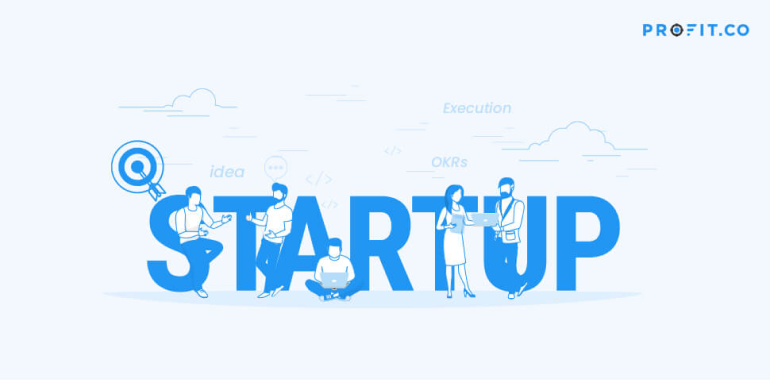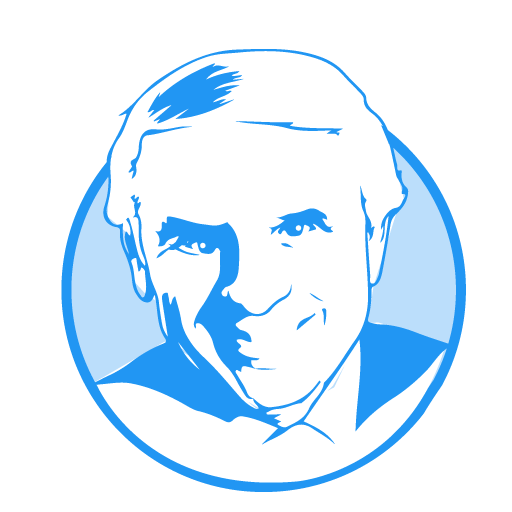The startup ecosystem has come a long way in recent years. In India alone, an average of 1300 startups are registered every year, 70% of which are tech startups. According to a report by Nasscom, the investments in startups had crossed 4.4 Billion USD in May 2019. But, how many of these startups survive in the long run?
Approximately 9 out of 10 of these startups shut down within the first five years of inception. Have you wondered why innovative ideas fail to turn into successful businesses?
Why do startups fail?
Top reasons why startups fail:
- Ignoring the importance of idea validating.
- Over-engineering the minimum viable product
- Not pivoting at the right time, and
- Lack of alignment between teams towards the vision.
Most of the time, founders tend to get distracted and stray from their path too often, burning too much cash in the process and bury their startups. This is why startups need OKRs. We’ve already documented the OKR payoffs, as advocated by John Doerr extensively – here’s a brief rundown of the benefits of OKRs:
Benefits of Using OKRs for Startups:
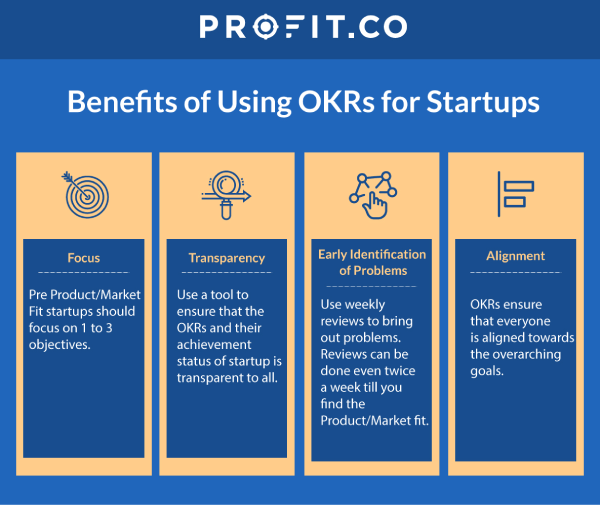
- Focus: With limited resources, it is important that everyone in a startup concentrate their energies on achieving the chosen objective. By clearly defining the OKRs and the time frame to achieve them, everyone absolutely knows what they need to do on a particular week or even day.
- Transparency: While using OKRs, particularly coupled with a good tool, everyone is clear about their goals and the achievement status of each OKR. This keeps everyone on the same page and helps reallocate resources to the teams that are falling behind.
- Early Identification of Problems: One of the biggest benefits of using OKRs is the ability to catch problems early. It’s a best practice to review OKRs on a weekly basis. This review enables employees to air their problems openly as every team is required to report their progress as well as confidence level in achieving their Key Results. In the case of early-stage startups, reviews can be done even twice a week till they find the product/market fit.
- Alignment: OKRs ensure that everyone is aligned towards the overarching goals so that all resources are dedicated to the most important projects and everyone is contributing towards the company’s top priorities.
Discipline is the bridge between goals and accomplishment.
As Steve Blank, the founder of the famous Lean Startup movement started, “Startups are not miniature versions of established large companies”. While large companies execute with proven business models, startups are in search of their own business models. Most startups fail because they do not find the right business model. In other words, they could not find the product/market fit and could not find enough paying customers.
Product/Market Fit:
The importance and power of the right product/market fit can be summed up with this quote from Andy Rachleff: “When a great team meets a lousy market, market wins. When a lousy team meets a great market, market wins. When a great team meets a great market, something special happens. If you address a market that really wants your product — if the dogs are eating the dog food — then you can screw up almost everything in the company and you will succeed. Conversely, if you’re really good at execution but the dogs don’t want to eat the dog food, you have no chance of winning.”
Finding the product/market fit should be the first priority for any startup that is aiming for success, or even to survive.
Finding Product/Market Fit with OKRs
Finding the product/market fit is not a straight-forward process. It requires defining hypotheses and testing them through iterative business execution. The following key principles of OKRs will be relevant for finding the product/market fit:
Let us consider the example of a startup that aims to find a profitable business model for selling organic pet food.
- Objectives: Objectives should be aspirational and should map to the hypotheses that the team would like to test. The initial hypothesis to test could be the value hypothesis– is there a market for organic pet food in major cities? The team may want to choose one area to test out their hypothesis. They may want to use different hypotheses for testing out other factors like price, delivery model, marketing communication etc.
- Key Results: Key results are metrics used to measure the success towards achieving an objective. In the above example, Key Results could be:
-
Selling to 1000 customers in one area
-
Achieving repeat order rate of 50%
-
At least 100 customers ready to provide online reviews
-
At least 100 customers ready to refer other customers
-
Help all the teams to focus on the customer problem and your solution to that problem.
-
Provide guardrails in the process of creating the prototype with minimal, but completely necessary features.
-
Avoid those features that are helpful and useful, but need not make the cut for the MVP. You can easily sell them as roadmap items.
-
New signups
-
New premium users signup.
-
Three Objectives or Less: As resources are limited, it will be a good idea to focus on just one or two objectives till the Product/Market fit is established. The upper limit should be three.
-
Plan Shorter Cycles: Aim for 2/3 week cycles to test hypotheses. Quarterly cycles are OK after Product/Market fit is established.
-
Focus on Learning: Startups should plan to obsessively learn during this phase. Having internal tools that can be used to record client interviews, have hashtagged conversations so that the field lessons are quickly disseminated across Sales, Customer Success, Product and Marketing teams.
-
Data before Ego: Not everyone can be a Steve Jobs – Having a great intuition about the market and designing products without market research is difficult for an overwhelming majority. Founders should put their ego aside and respect the “market” while testing their hypotheses and be ready to Pivot early while they still have the funding left.
In 4 weeks:
How can startups stay focused using OKRs?
Ideally, you should only define 3-5 objectives per OKR level at any point in time with 3-5 key results for each Objective. The OKR methodology is self-regulating and forces you to narrow down your to-do list. And not just that. The to-do list is not a to-do list, but it is a to-accomplish list. There is a subtle difference here. To- do focuses on outputs, whereas to-accomplish focuses on results. OKR allows founders and their teams to forecast outcomes, pursue them, and track them relentlessly.

How can OKRs help with validating the idea?
Founders have to validate their idea before they roll up their sleeves and plunge into developing the product. They have to be sure if customers will happily pay for using the product or the service. Ignoring idea validation will lead them to build something that nobody wants. They could burn a lot of cash and spend more energy on developing a solution around the idea, only to find out that no one intends to buy it.
A simple OKR with key results as shown below is sufficient to validate the product idea. This OKR is time-bound and will guide the founders to be focused on the metrics and work towards achieving the numbers. It will also cut out the execution of new ideas that will pop up in their mind and focus on what matters to reach the Objective.
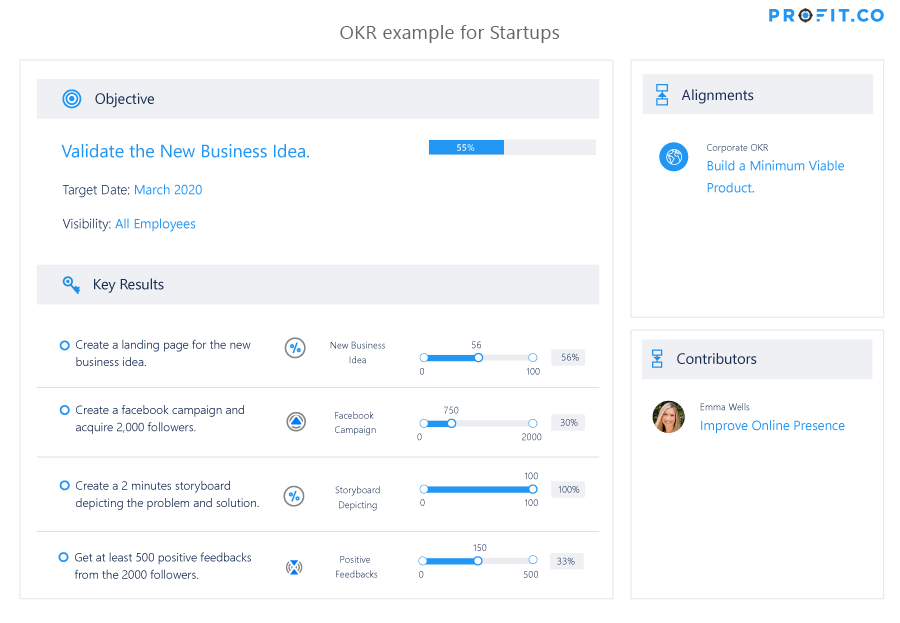
If the founders achieve these key results, then they could go to the next step of building their prototype. What if they don’t meet those numbers? They can reiterate with appropriate modifications based on the feedback that is received from the campaign. If they don’t get to their thresholds after multiple iterations, then you can conclude that the market is not ready for the idea and decide that it’s not worth pursuing it.
Do you know that Dropbox didn’t have a real product in the beginning?
Dropbox is a file storage service used to save and share files across different platforms and operating systems. To get this product done, it requires specialized expertise and a vast amount of resources.
Drew Houston, the founder of Dropbox, created a simple video demonstrating Dropbox in action. It showed how seamlessly it works across different operating systems and uploaded the video to the website. It drove thousands and thousands of people to the website, and their beta waiting list went up from 5000 to 75000 overnight. Anyone who watches the video will assume that the video is a product demonstration, while there was no real product in existence.
As you can see, it’s a lot easier & inexpensive to test a concept than a real product.
How can OKRs help you to build the right MVP?
After testing the idea, you create a minimum viable product. MVP is a prototype of the product, built with minimal features to test the product and to see how customers interact with it.
In traditional product development, we tend to pick up any good idea that strikes in our mind. Sometimes these ideas are misconceived to be useful features, and the development team might as well want to incorporate these into the MVP.
This act of adding a new feature out of the blue to the planned modules will push the release dates further away from the scheduled time. If startups consume more time only to produce trivial features, it also gives an edge to the competitors. This position will favor the new entrants in the same niche and puts the original thinker in a position to lose some market share. It takes discipline to narrow down the objectives.
When you use OKRs to develop MVP, you can create a focused list of features and execute them. OKRs can prove very handy for startups at this stage. OKRs can help startups in the following ways:
Here we will see how a startup can set up their OKR.
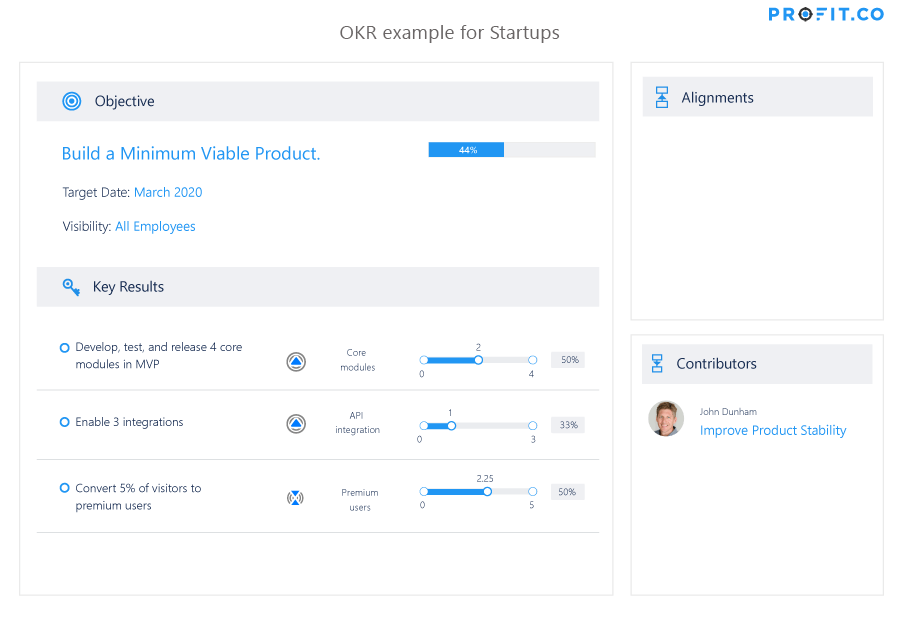
This OKR or some version of it will help the team deliver an MVP at the earliest to the marketplace. It will keep the team laser focussed on essentials and avoids doing activities that may arise out of their own perceptions and preferences.
How can OKRs help you pivot at the right time?
The main goal of MVP is to test how the market reacts to your product. You should gauge customers’ behavior and analyze your MVP’s performance and measure the results. MVP results could be measured as:
Or any other measure through which you can measure the success of the MVP.
Comparing the results against your expectations will provide confidence and direction to your next iteration of the product. It will not only save your startup from building something that nobody requires, but it can actually guide you on the critical path to something that everyone wants.
Tips for making OKRs work for Startups:
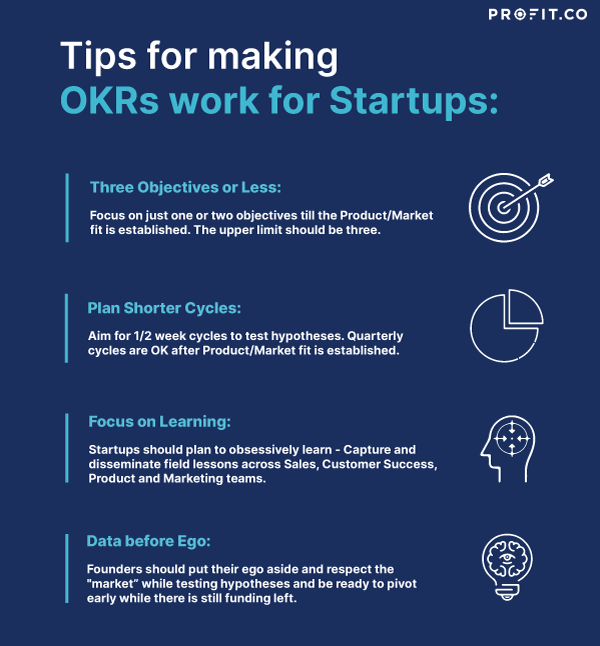
OKRs can be a great tool for startups of any size provided they are used diligently applying the core principles stated here. Teams need to have an open culture valuing transparency, should be ready to go out to the market and test their hypotheses and rapidly recalibrate their offerings till they find the product/market fit.
For a software solution that helps you transparently focus, measure, and achieve your objectives and key results, look no further than Profit.co! Book a free demo with our OKR experts to see how this powerful tool can kickstart your start-up’s success today!
